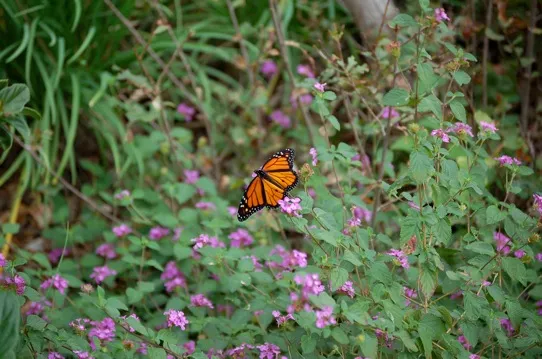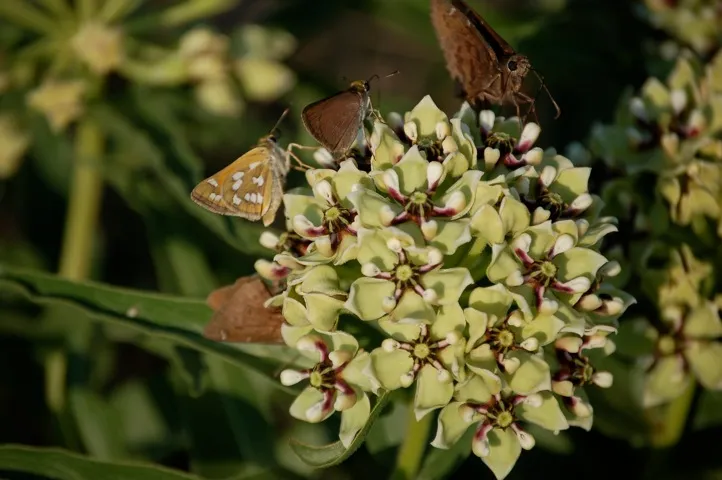By Delmar Cain
I have reports that “they” are back. I told my friend Kip Kiphart that I thought that I had seen one last week in Boerne and another at my house a few days later. But the ones that I saw were some distance away and neither slowed down to say hello. But my information is not always reliable for Kip. He has other sources that are “bona fide” and they have spoken.

The “they” that I am referring to are monarch butterflies. An authoritative reporter in Bergheim has seen a monarch and found 27 eggs on the Antelope horns (Asclepias asperula) in a monitored patch. And Kip found monarch eggs on Hierba de Zizotes (Asclepias oenotheroides) another milkweed species that grows near his house.
Of course a reasonable question is if the monarchs are back, where have they been. And the answer is that they spent the winter at their resort in Mexico, having made a long journey south from northern states or even from southern Canada last fall. But time is short, because the ones that are returning now don’t have much longer to live. The females will have to find the right kind of host plants and lay eggs before they die, having already lived much longer than most species of butterflies. To find out more about the amazing life cycle of the monarch go to an informative website: www.monarchwatch.org
For those following the comings and goings of the monarchs there have been ample reasons for concern in recent years. Experts have anxiously watched the destruction of monarch wintering grounds in Mexico, the loss of summer habitat from development, herbicides and farming and the use of systemic pesticides on garden plants. These factors together have contributed to an inevitable decline in numbers.
The devastating drought in Texas has only added to that concern, because Texas is positioned at a critical location on the migratory routes in both the fall and in the spring. Insufficient nectar plants in Texas in the fall for the migrating adults heading to Mexico or insufficient host plants in Texas in the spring upon which the returning females will deposit their eggs might tip the scales against the continued existence of this magnificent insect.

Rather than just watch a bad situation get worse, Chip Taylor, the Director of Monarch Watch has tried to respond with a nationwide restoration landscape program called “Bring Back The Monarchs.” The stated goals of the program are “to restore 20 milkweed species, used by monarch caterpillars as food, to their native ranges throughout the United States and to encourage the planting of nectar-producing native flowers that support adult monarchs and other pollinators.” For more information on this restoration project and the varieties of milkweed included check out the website: monarchwatch.org/bring-back-the-monarchs/
Some of the folks in our area are responding to the call. Kip Kiphart and Mary Kennedy were instrumental in marking off a monarch survey station at the Cibolo Nature Center, where trained volunteer monitors periodically count the milkweed plants and carefully look for the tiny pearl-like monarch eggs. In our area of Texas two of the more preferred native milkweeds, which the monarchs use as host plants, are antelope horns (Asclepias asperula) and Hierba de Zizotes (Asclepias oenotheroides). Residential development, right of way mowing and incompatible farm and ranching operations have had an affect on the numbers of these milkweed plants.
Last fall in a program called Milkweed for Monarchs Kip encouraged members of the Boerne Chapter of NPSOT to collect seeds from both antelope horns and from Hierba de Zizotes. The collected seeds were sent to an Austin grower, who has now made hundreds of small plants available from the germinated seeds.
For the past several years at the CNC sponsored Mostly Native Plant Sale, Kip has provided a butterfly demonstration garden, which included some of the better nectar plants in our area to attract butterflies, including monarchs. This year in addition to showing you beautiful nectar plants he will be selling the native host plants.
So on April 7th when you attend the 22nd Mostly Native Plant Sale, look for the butterfly demonstration garden to find out which nectar plants attract monarchs and other butterflies. Many of those plants will be available and for sale at the NPSOT booth. But you can really help, if you will purchase milkweed plants and plant them in your yard or garden. Look for Kip’s booth where antelope horns and perhaps Hierba de Zizotes will be for sale.
Then next year you too can join the group that is excited about hearing that “they” are back.
